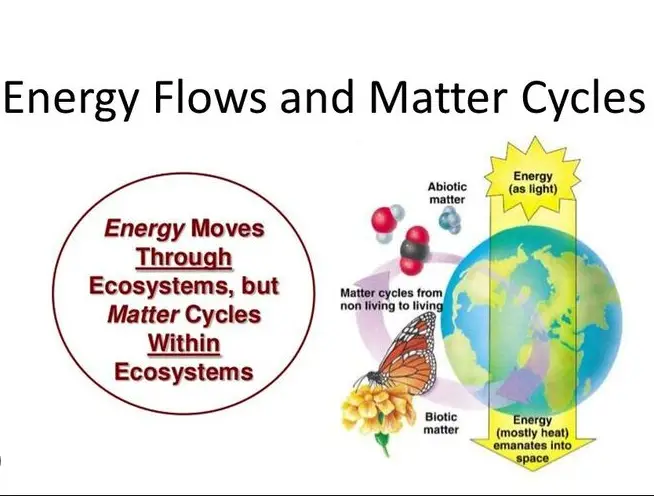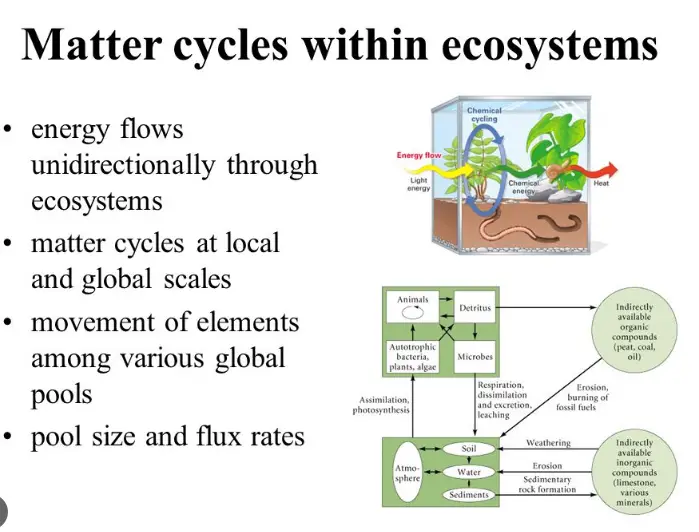Ecosystems operate through two fundamental processes: energy flow and matter cycling. These mechanisms are crucial for maintaining the balance of nature and supporting life on Earth. Both play distinct roles but are interconnected in ways that ensure the survival and productivity of ecosystems.
Energy flow in ecosystems begins with sunlight, utilized by plants to create energy through photosynthesis. This energy supports various life forms across multiple trophic levels, from producers to apex predators. In contrast, matter cycling involves the recycling of organic and inorganic materials, like carbon and nitrogen, ensuring that essential nutrients are reused within the ecosystem.
While energy flows through an ecosystem entering as sunlight and leaving as heat, matter is recycled within the ecosystem. This fundamental difference highlights how ecosystems manage resources and sustain various forms of life. Both processes are vital for ecological balance and have profound implications on everything from local biodiversity to global environmental conditions.

Energy Flow Basics
Definition and Concept
Energy flow in an ecosystem refers to the transfer of energy from one part of the ecosystem to another. This process begins with solar energy, which is captured by producers, primarily plants, through photosynthesis. The energy is then transferred through the ecosystem via the food chain, from producers to consumers and finally to decomposers.
Role in Ecosystems
The role of energy flow is crucial in maintaining the health and productivity of ecosystems. It drives the ecological processes that support life, allowing organisms to perform essential functions such as growth, reproduction, and movement. Without a continuous flow of energy, ecosystems would fail, leading to a collapse in biodiversity and the services they provide.
Matter Cycling Overview
Defining Matter Cycling
Matter cycling involves the repeated reuse and recycling of chemical elements such as carbon, nitrogen, and phosphorus within an ecosystem. These elements are used by living organisms to carry out biological processes and are passed through the food chain. When organisms die, decomposers break them down, returning these elements to the soil, air, and water, where they can be reused by other living organisms.
Significance in Nature
The significance of matter cycling lies in its ability to sustain life by providing essential nutrients in a usable form. It ensures that ecosystems are supplied with the necessary elements to support a diverse range of life forms. Matter cycling helps maintain ecological balance and supports the functioning of global processes like the carbon cycle and nitrogen cycle.
Comparing Processes
Energy Flow vs. Matter Cycling
While both energy flow and matter cycling are fundamental to ecosystem dynamics, they differ in several key ways. Energy flow is unidirectional, always moving from producers to consumers and eventually lost as heat. In contrast, matter cycling is cyclical, with elements continually recycled within the ecosystem without being lost.
Direction and Permanence
The direction of energy flow and the cyclical nature of matter cycling highlight their roles in ecosystem permanence. Energy’s one-way path emphasizes its role in driving immediate biological processes, whereas the recycling of matter underlines its importance in long-term ecosystem sustainability.
Components of Energy Flow
Sunlight as Primary Source
Sunlight is the primary source of energy for most ecosystems. It is harnessed by plants through the process of photosynthesis, where it is converted into chemical energy stored in organic compounds. This energy becomes the foundation for all higher trophic levels within the ecosystem.
Trophic Levels Explained
Trophic levels categorize the different roles organisms play in energy flow:
- Producers: Typically plants and algae, which convert solar energy into organic compounds.
- Consumers: Organisms that consume producers (herbivores) or other consumers (carnivores).
- Decomposers: Break down dead material, releasing nutrients back into the ecosystem and completing the energy flow cycle.
Energy Transfer Efficiency
Energy transfer between trophic levels is not highly efficient, with only about 10% of the energy being passed from one level to the next. This loss of energy as heat at each trophic level limits the number of trophic levels and thus the amount of energy available at higher levels of the food chain.

Matter Cycling Pathways
Biogeochemical Cycles
Matter cycling in ecosystems is largely governed through biogeochemical cycles—the pathways by which essential elements and compounds move through Earth’s various compartments. Key cycles include the carbon cycle, nitrogen cycle, water cycle, and phosphorus cycle. Each of these cycles plays a critical role in maintaining the health and functionality of ecosystems by ensuring that nutrients are cycled effectively and remain available to support life.
Role of Decomposers
Decomposers, such as fungi and bacteria, are integral to matter cycling. They break down dead organic material, returning nutrients like nitrogen and phosphorus back into the soil, making them available for reuse by producers. This role not only sustains nutrient availability but also prevents the build-up of dead material, which could disrupt ecosystem processes.
Interdependence
Interactions Between Energy and Matter
Energy flow and matter cycling are deeply intertwined within ecosystems. Energy captured by producers drives the synthesis of organic compounds, which are then used and recycled by other organisms within the food chain. These interactions ensure that energy sustains the physical processes that recycle matter, illustrating the complex web of dependency among various ecosystem components.
Ecosystem Stability and Health
The stability and health of ecosystems rely heavily on the efficient interaction of energy flow and matter cycling. A balanced energy flow supports a robust food chain, while effective matter recycling ensures nutrient availability, preventing ecosystem degradation and promoting resilience against environmental stresses.
Case Studies
Forest Ecosystems
Forest ecosystems vividly illustrate the interplay of energy flow and matter cycling:
- Energy Flow: Solar energy is captured by a dense canopy of trees and plants, supporting a diverse array of wildlife.
- Matter Cycling: Fallen leaves and dead trees decompose, enriching the soil and fostering a fertile ground for new growth. These processes contribute to the forest’s ability to sustain a wide variety of life forms and maintain ecological balance.
Aquatic Systems
In aquatic systems, these processes manifest differently:
- Energy Flow: Phytoplankton absorb sunlight, serving as the primary energy source for aquatic food webs.
- Matter Cycling: Nutrients are cycled through water layers and sediment, involving complex interactions among aquatic plants, animals, and microorganisms. These dynamics ensure the productivity and stability of freshwater and marine environments.
Human Impact
Influence on Natural Processes
Human activities have profound impacts on both energy flow and matter cycling. Deforestation, pollution, and climate change can alter these natural processes, often leading to diminished ecosystem functionality. For example, pollution can disrupt the nitrogen cycle, causing both nutrient deficiencies and toxic accumulations in environments.
Conservation Efforts
Efforts to conserve and restore natural processes focus on:
- Protecting Ecosystems: Establishing protected areas to safeguard natural habitats.
- Restoring Damaged Areas: Implementing reforestation and wetland restoration projects.
- Promoting Sustainable Practices: Encouraging agriculture and industry practices that reduce environmental impact. These actions are vital for maintaining the health of the planet, ensuring that energy flow and matter cycling can continue to support life effectively.
Frequently Asked Questions
What is Energy Flow?
Energy flow refers to the movement of energy through a food chain in an ecosystem. It starts with the absorption of sunlight by producers, passes through consumers, and dissipates as heat back into the atmosphere. This process is crucial for the survival of all organisms as it dictates the energy availability at each trophic level.
How Does Matter Cycle?
Matter cycling involves the continuous movement of elements like carbon, nitrogen, and oxygen through various forms and compartments of the Earth, including the atmosphere, lithosphere, hydrosphere, and biosphere. Decomposers play a critical role by breaking down dead organisms, which recycles nutrients back into the ecosystem.
Why Are These Processes Important?
Energy flow and matter cycling are essential for sustaining life, as they ensure that energy and essential nutrients are appropriately distributed and reused within ecosystems. They contribute to ecosystem resilience, support biodiversity, and help maintain environmental stability.
How Do Humans Impact These Processes?
Human activities, such as deforestation, pollution, and overuse of resources, significantly impact both energy flow and matter cycling. These actions can disrupt these natural processes, leading to reduced ecosystem functionality, loss of biodiversity, and ecological imbalance.
Conclusion
Understanding the dynamics of energy flow and matter cycling is crucial for appreciating how ecosystems function and sustain life. These processes not only highlight the intricate balance of nature but also emphasize the responsibility humans have in preserving this balance. By fostering practices that protect and enhance these natural cycles, we contribute to a sustainable future.
As the global community becomes more aware of environmental issues, the significance of maintaining healthy ecosystems through sustainable practices cannot be overstated. It is imperative for research, policy, and conservation efforts to focus on these fundamental ecological processes to ensure the health and longevity of our planet.

